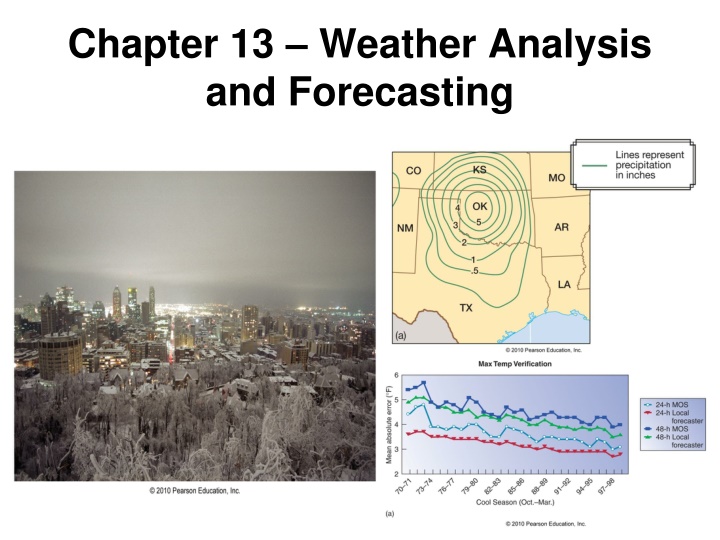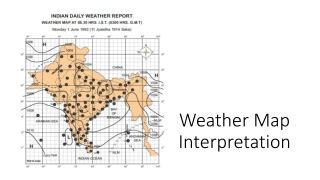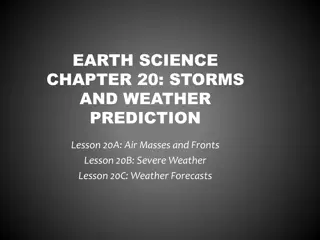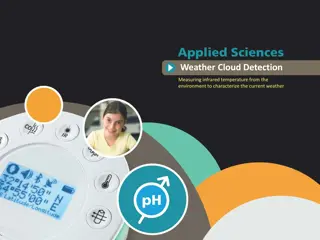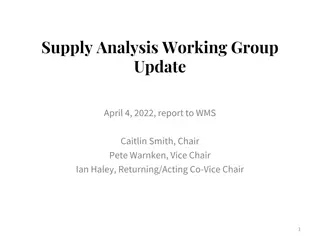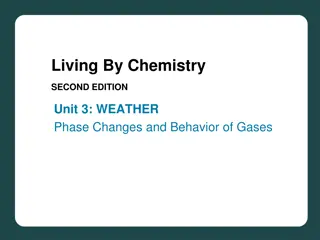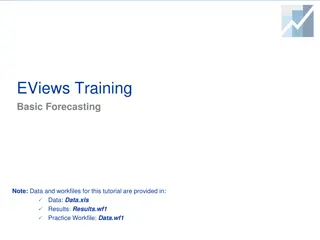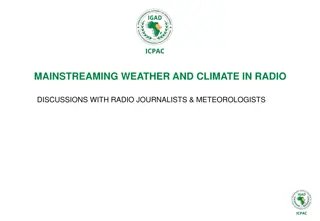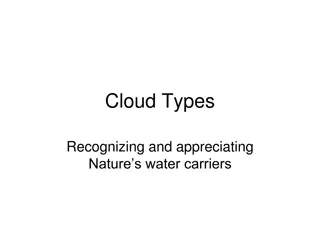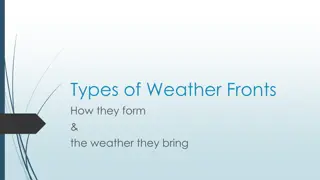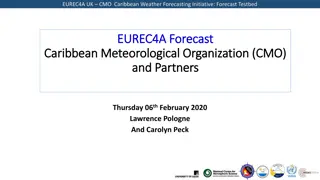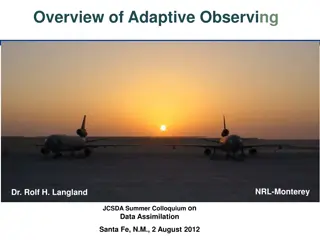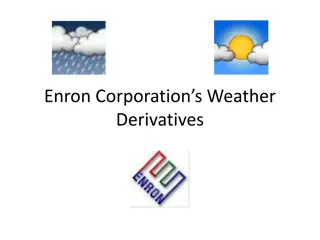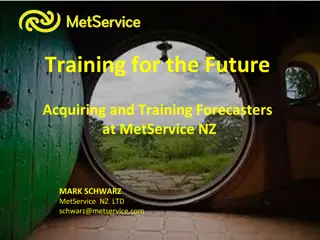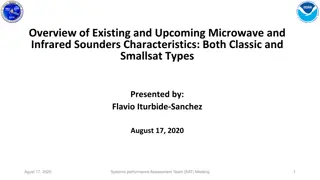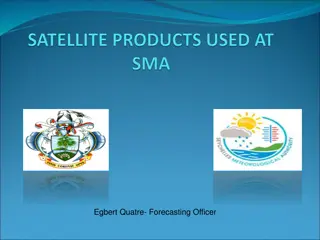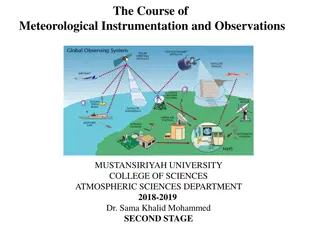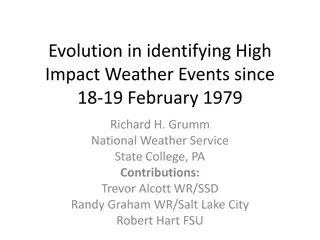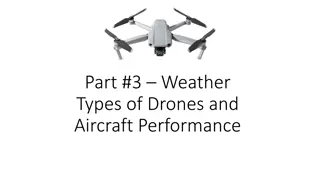Weather Analysis and Forecasting Overview
The National Weather Service (NWS) provides comprehensive forecasts and warnings through different Weather Forecast Offices (WFOs). NWS forecasters utilize the Advanced Weather Information Processing System (AWIPS) for current conditions and forecasts. Various products, including short-term forecasts, aviation forecasts, and marine forecasts, are generated at NWS WFOs.
Download Presentation

Please find below an Image/Link to download the presentation.
The content on the website is provided AS IS for your information and personal use only. It may not be sold, licensed, or shared on other websites without obtaining consent from the author.If you encounter any issues during the download, it is possible that the publisher has removed the file from their server.
You are allowed to download the files provided on this website for personal or commercial use, subject to the condition that they are used lawfully. All files are the property of their respective owners.
The content on the website is provided AS IS for your information and personal use only. It may not be sold, licensed, or shared on other websites without obtaining consent from the author.
E N D
Presentation Transcript
Chapter 13 Weather Analysis and Forecasting
The National Weather Service The National Weather Service (NWS) is responsible for forecasts several times daily
The National Weather Service The National Weather Service (NWS) is responsible for forecasts several times daily Different weather forecast offices (WFOs) are responsible for their specific region
The National Weather Service The National Weather Service (NWS) is responsible for forecasts several times daily Different weather forecast offices (WFOs) are responsible for their specific region WFOs are also responsible for warnings in their specific region
The National Weather Service The National Weather Service (NWS) is responsible for forecasts several times daily Different weather forecast offices (WFOs) are responsible for their specific region WFOs are also responsible for warnings in their specific region NWS forecasters rely heavily on the Advanced Weather Information Processing System (AWIPS) to understand current conditions and make forecasts
The National Weather Service A variety of products are created at NWS WFOs
The National Weather Service A variety of products are created at NWS WFOs Short-term forecasts 7-day zone forecasts Aviation forecasts Marine forecasts Forecast discussions
The Forecasting Process Forecasts from now out to a few hours is called nowcasting
The Forecasting Process Forecasts from now out to a few hours is called nowcasting Strongly based on observations (radar, satellite images, surface observations)
The Forecasting Process Forecasts from now out to a few hours is called nowcasting Strongly based on observations (radar, satellite images, surface observations) Forecasts beyond about 6 hours is based mostly on numerical weather prediction (NWP) models
Numerical Weather Prediction The Analysis Phase A gridded, 3-dimensional analysis is produced with 1) A previous forecast
Numerical Weather Prediction The Analysis Phase A gridded, 3-dimensional analysis is produced with 1) A previous forecast 2) Observations
Numerical Weather Prediction The Analysis Phase A gridded, 3-dimensional analysis is produced with 1) A previous forecast 2) Observations The process by which the above are combined is called data assimilation
Numerical Weather Prediction The Prediction Phase The prediction phase of NWP involves calculating the future state of the atmosphere (starting point = the analysis) under the following governing equations: 1) Conservation of momentum
Numerical Weather Prediction The Prediction Phase The prediction phase of NWP involves calculating the future state of the atmosphere (starting point = the analysis) under the following governing equations: 1) Conservation of momentum 2) Conservation of mass
Numerical Weather Prediction The Prediction Phase The prediction phase of NWP involves calculating the future state of the atmosphere (starting point = the analysis) under the following governing equations: 1) Conservation of momentum 2) Conservation of mass 3) Conservation of energy
Numerical Weather Prediction The Prediction Phase The prediction phase of NWP involves calculating the future state of the atmosphere (starting point = the analysis) under the following governing equations: 1) Conservation of momentum 2) Conservation of mass 3) Conservation of energy dv dt V2-V1 t Example: F = ma = m = m
Numerical Weather Prediction The Prediction Phase NWP takes massive amounts of computing power!!!
Numerical Weather Prediction The Prediction Phase NWP takes massive amounts of computing power!!! 1980s: U.S. nested grid model 80-km resolution over continental U.S. (48-hr forecast runtime = hours)
Numerical Weather Prediction The Prediction Phase NWP takes massive amounts of computing power!!! 1980s: U.S. nested grid model 80-km resolution over continental U.S. (48-hr forecast runtime = hours) Today: Weather Research and Forecasting model 12-km resolution over U.S. (48-hr forecast runtime = 10 minutes)
Numerical Weather Prediction The Prediction Phase NWP can be classified in 2 ways: produced and relied upon 1) Deterministic a single forecast is
Numerical Weather Prediction The Prediction Phase NWP can be classified in 2 ways: produced and relied upon 1) Deterministic a single forecast is produced and forecast probabilities can be generated (ensemble forecasting) 2) Probabilistic many forecasts are
Deterministic vs. Probabilistic Forecasting Time = 00-hr
Deterministic vs. Probabilistic Forecasting Time = 00-hr Time = 72-hr
Probabilistic Forecasting 10-day forecasts
Probabilistic Forecasting Main challenge = Expressing uncertainty to the public in a way it will be useful
Probabilistic Forecasting Main challenge = Expressing uncertainty to the public in a way it will be useful - Do people want to hear what the high temperature will be, or do they want to know the possible range of high temperatures?
The Prediction Phase How Can Forecasts Go Bad? There are 2 main sources of error in NWP forecasts: 1) Initial condition error errors in the analysis of a NWP model
The Prediction Phase How Can Forecasts Go Bad? There are 2 main sources of error in NWP forecasts: 1) Initial condition error errors in the analysis of a NWP model 2) Physics errors physics that are wrong in the NWP model (mostly associated with surface processes)
Initial Condition Error Initial condition errors are always present in NWP analyses
Initial Condition Error Initial condition errors are always present in NWP analyses Because of chaos, errors in the analysis will eventually grow to be large (forget about 30- day forecasts!)
Physics Errors The physics in NWP models aren t perfect
Physics Errors The physics in NWP models aren t perfect - Surface radiation processes
Physics Errors The physics in NWP models aren t perfect - Surface radiation processes - Frictional turbulence of surface winds
Physics Errors The physics in NWP models aren t perfect - Surface radiation processes - Frictional turbulence of surface winds - Convection
Physics Errors The physics in NWP models aren t perfect - Surface radiation processes - Frictional turbulence of surface winds - Convection - Cloud processes
Physics Errors Physics errors often lead to model biases consistent errors in certain model variables (e.g. surface temperature)
Numerical Weather Prediction The Post-processing Phase The post-processing phase of NWP involves creating graphics of the forecast:
Numerical Weather Prediction The Post-processing Phase The post-processing phase of NWP involves creating graphics of the forecast: 1) 500-mb height 2) SLP 3) Surface wind 4) 3-hr precipitation 5) 1000-500mb thickness
NWP Post-processing The final forecast product includes the human factor judgments based on both a forecaster s experience and NWP
NWP Post-processing Model Output Statistics (MOS) a post- processing technique that correlates relationships between a model forecast and reality over many, many forecasts
NWP Post-processing Model Output Statistics (MOS) a post- processing technique that correlates relationships between a model forecast and reality over many, many forecasts MOS produces a forecast incorporating these statistical relationships
Forecast Verification Forecast verification is the process of measuring the skill of a forecast (model, human forecaster, MOS )
Forecast Verification Forecast verification is the process of measuring the skill of a forecast (model, human forecaster, MOS )
Long-range Forecasts The Climate Prediction Center (CPC) is responsible for forecasts valid more than 1 week into the future (numerical models and statistics)
